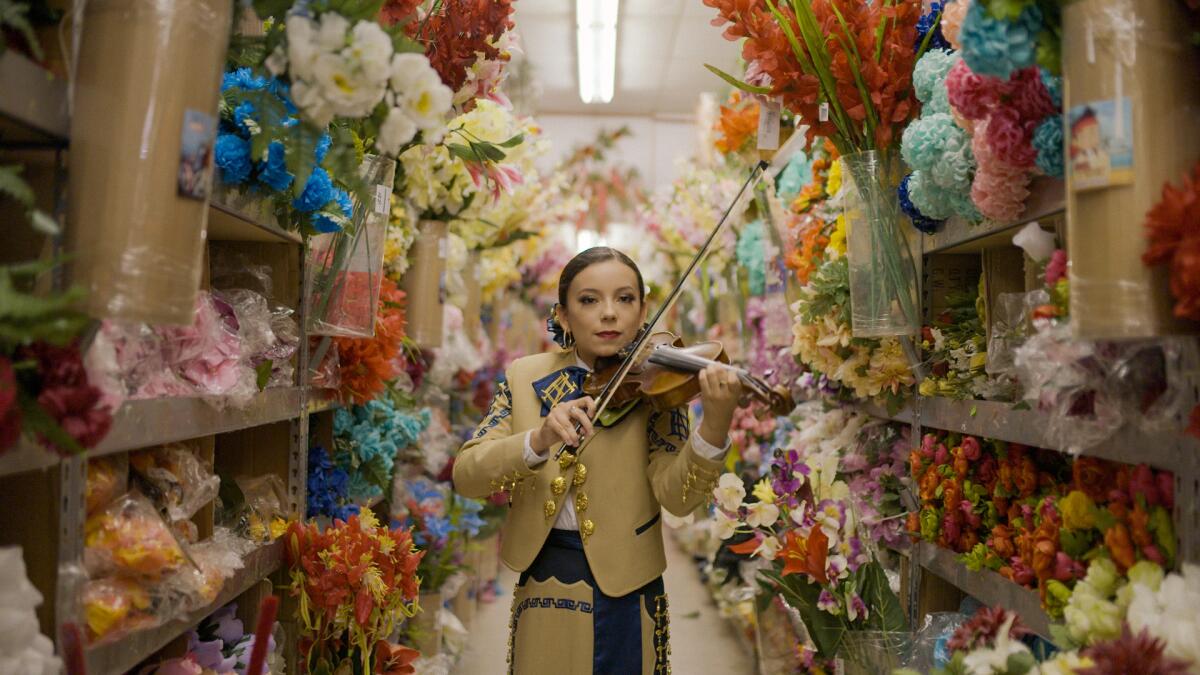Latinx Files: ‘Going Varsity in Mariachi’ is the narrative the border deserves

- Share via
“Going Varsity in Mariachi,” the endearing documentary about the world of competitive high school mariachi in Texas, is finally available on streaming.
The film, which had its world premiere at the 2023 Sundance Film Festival, became available on Netflix last week in North and South America under a licensing agreement — the streaming giant didn’t buy it and is instead paying a fee to show it.
Directed by Alejandra Vasquez and Sam Osborn, “Going Varsity in Mariachi” follows the band members of Mariachi Oro de Edinburg North High School over the course of the 2021-2022 school year in their quest to win the state championship. The film is set in the Rio Grande Valley (puro 956, cuh!), a borderland slice of South Texas where the Mexican and the American meet, mingle and fuse. The region is home to some of the best mariachi programs in the state, many of which were established years before the University Interscholastic League, the governing body that oversees high school extracurricular competitions in Texas, sanctioned its first mariachi contest in 2018.
The film wins you over with its cinema verite depictions of teens being teens. Under the guidance and leadership of director Abel Acuña, the young musicians master mariachi staples such as “Volver, Volver” and “El Rey” as they navigate everyday high school life — applying to college, making prom proposals and learning how to drive.
But perhaps “Going Varsity in Mariachi’s” biggest achievement is that it offers a refreshing portrayal of the border rarely seen in film, television or the news. It’s not a narrative about immigration or border enforcement, but rather it’s a documentary about cultural traditions being preserved and passed on to the next generation.
In honor of the film being available on Netflix, I’m resurfacing a Q&A I did with the filmmakers shortly after its Sundance premiere. The following appeared in the Jan. 26, 2023, edition of the newsletter.
You’re reading Latinx Files
Fidel Martinez delves into the latest stories that capture the multitudes within the American Latinx community.
You may occasionally receive promotional content from the Los Angeles Times.
How did this film come about?
Osborn: The project for us kind of got started once we heard that UIL was sanctioning mariachi at the same level as cheerleading, football and marching band. We were drawn to the intersection of a culturally specific arts program and it being near the border in a state like Texas. We saw a lot of interesting ideas in the very simple act of its existence.
What struck me about this film was that it was very much a border story, and one in which immigration is not at the foreground.
Osborn: We talked a lot about how much we wanted to foreground immigration politics in the film, and some days I would think, “Guys, there are refugee camps 30 minutes away on the other side of the border. How could we not address them?”
But I think we realized that we didn’t want to clumsily force that into the movie, and that the fact that this team and this program’s existence is political in itself. It is a recognition that generations and generations of immigrants have settled on this side of the border and are now putting their kids through American schools. That competitive mariachi exists is a knockdown effect of this. These public schools have programs that are thriving, and schools across the road or across the state are trying their best to keep up with the appetite of these families and students who really want to be a part of it. I wouldn’t call it an immigration story either, but rather a story about what happens to a population generations after the border has been crossed.
Vasquez: It was really important for us just to tell a story that put things like joy and hope and excitement at the foreground. A lot of Latino stories tend to be more about trauma and firsthand immigration narratives. I think those stories are really important, but this kind of felt like a story that was celebrating our culture.
As I watched the film, I couldn’t help but to think about how these kids felt very American. There’s a scene in which mariachi director Abel Acuña asks his students what they know about José Alfredo Jiménez, arguably Mexico’s greatest singer-songwriter, and the best they could muster was that he had a mustache. It felt a little shocking, but it also made me realize that these kids’ roots are one or two generations further entrenched in this country than my own.
Osborn: It’s a mix, right? The film doesn’t explicitly go into this but some of the kids are translating for their parents, some have undocumented parents, and there are others who don’t speak Spanish. They’ve never heard of José Alfredo Jiménez. It really is a mix. Entering the classroom for the first time, we were struck by how they had different connections to the music and to their culture.
Vasquez: What we thought was special was that they were all making the choice to learn mariachi. They all auditioned to be there, and even if they don’t have such a strong connection to mariachi, they still made the choice to be there. They weren’t forced.
It’s funny because I grew up in the RGV and mariachi was definitely a thing at my high school, but I didn’t realize just how competitive it really is. As your film points out, there’s no better example of that than the mariachi program at Roma High School. Can you tell me a little bit more about that?
Vasquez: Roma is the shining star of the mariachi world. They start out in the fifth grade, where they take an aptitude test first and then they audition. You can’t join the varsity team if you weren’t already in the mariachi program in the fifth grade.
Osborn: Something we haven’t talked much about is the institutionalization that’s happening to mariachi, where it’s being shifted to be this very American, competition-oriented thing. There’s this trend toward institutionalization, where it becomes less of a cantina or club thing and becomes more of a school thing. I have mixed feelings on this. On the one hand, it helps take stock of mariachi’s history and really honors it. But a lot of people could probably also argue that it’s holding it back in some ways. I wonder how this process will affect this traditionally Mexican music.
Vasquez: It’s also happening to conjunto, which is so fascinating. Conjunto programs are growing across the RGV and all over Texas. Coach Abel Acuña now has a conjunto program and started teaching a conjunto class this year. It’s been so popular that it’s expanded to two classes.
There’s a scene that just blew me away. It takes place after the kids compete at the Mariachi Vargas Extravaganza in San Antonio, and they’re sitting in the classroom very deflated. To get them back on track, the teacher asks them earnestly what mariachi means to them. One of the students says she first heard the music at a funeral and was taken aback how it could evoke such feelings. She did an amazing job at capturing the essence of mariachi, that it’s so visceral and something you feel.
Vasquez: We love that scene.
Osborn: I think that’s the heart of the movie. We restrained ourselves from giving people a history lesson on what mariachi actually is, and having that scene kind of filled that gap for us. These students are recognizing how mariachi can function in their lives without having learned the play-by-play, Wikipedia version of the history. They get to experience it instead of being lectured about it. Mariachi is a way you can express your emotions, feel included in your culture and in your high school.
How did you two choose Edinburg North High School as the program to chronicle in your documentary?
Vasquez: What we really loved about that program was Coach Acuña and his philosophy. We had made a short film on the same team in 2020, and we really learned that he was not just about the trophies. He was more about how mariachi can be used in these students’ lives and how it can enrich them and their culture, how it can get them through high school and into adulthood. Meeting him and learning more about his philosophy and his approach made us interested in making something longer with him.
Osborn: We didn’t want to make a straight-up competition film, either. We wanted to make something that felt more coming of age and a little looser. It’s more about these kids’ lives instead of whether they’ll be champions or not.
Why is it that schools in the Rio Grande Valley dominate these competitions?
Vasquez: There’s a lot of reasons. Because they’re on the border. Because you can study mariachi in middle school, high school and in college in the RGV— a lot of these educators went to school and studied mariachi at the University of Texas Rio Grande Valley, and now they’re mariachi directors in their own right.
Osborn: Dr. Dahlia Guerra, who runs the mariachi program at UTRGV, I believe the majority of the school program directors in the region were trained by them. There’s this whole tree of mariachi training, and most stay in the region.
Consider subscribing to the Los Angeles Times
Your support helps us deliver the news that matters most. Become a subscriber.

Stories we read this week that we think you should read
For Natalia Lafourcade, playing the Hollywood Bowl again is the next step in her storied journey
Over the last two decades, Mexican singer-songwriter Natalia Lafourcade has established herself as one of the most revered and celebrated artists from Latin America, a custodian of Mexico’s rich songbook who has contributed extensively to it. Her 10 studio albums have earned her 17 Latin Grammys — the most for any female artist — and four Grammys. On Friday and Saturday, she’ll be performing at the Hollywood Bowl with Gustavo Dudamel and the Los Angeles Philharmonic.
How J Balvin’s thoughts about his first car reconnected him with reggaeton
Colombian singer-songwriter J Balvin didn’t set out to make an album. All he wanted was to fall back in love with making music. ‘Rayo,’ his seventh studio album, is the result of that rekindling.
“A Woman Named Gloria,” by playwright Josefina Lopez, pays tribute to Gloria Molina, an icon of Latino politics in Los Angeles. The play is currently being staged at Casa 0101 in Boyle Heights, and it explores Molina’s political rise, the challenges of public service and a legacy that lives on.
María Zardoya, of the Marías, chooses to relive her breakup every night
With an EP on the horizon and upcoming tour dates in Europe, the Marías’ frontwoman, María Zardoya, speaks about the realities of touring a breakup album.
12 must-try dishes that celebrate L.A.’s vibrant Salvadoran food scene
From saucy pan con pollo in Huntington Park to protein-packed pastelitos in Pico-Union, the Times Food team has put together this handy guide of 12 places in Los Angeles that showcase the depth of Salvadoran cooking.
The Latinx experience chronicled
Get the Latinx Files newsletter for stories that capture the multitudes within our communities.
You may occasionally receive promotional content from the Los Angeles Times.




